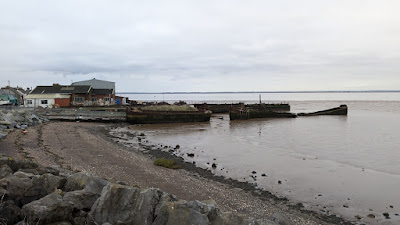Another very gloomy day of dark clouds. On the positive side, it wasn't drizzling and it was very still, making for a pleasant 11 km walk. I take the X7 bus to the village of Thorngumbald and then walk along Church Lane. There are Rooks and Jackdaws around and Starlings whistle from trees and aerials. A flock of Golden Plover and a skein of Pink-footed Geese fly over. I turn west at Hooks Lane, which soon becomes Dark Lane. It is a tarmaced road, but not too busy. The villages along the A1033 to Easington were sited just by the marshes of the Humber before land reclamation, drainage and the improvements of the seawall by the Humber rendered them well inland. Many names in OS maps in the area indicate this reclaimed aspect of the land: Green Marsh, South Marsh, Thorn Marsh, Out Marsh and Far Marsh. The rich, level reclaimed silt means they are now all arable. It is likely that prior to reclamation the saltmarshes were used to summer cattle and sheep.
There is a rise in the horizon, the beautifully named Boreas Hill, peaking at 16 m over the sea level. It is the remains of a terminal moraine left after the last ice age. In Holderness the soft ridges and hills often are. The hill is of irregular shape and wooded. Jays call from the trees. As I walk up, the shiny ribbon of the Humber becomes visible.
As I descend towards Paull Holme, on the fields there is a flock of Curlew feeding with gulls. I'm soon by Paull Holme Strays realignment site, but I don't linger, skirting it towards Paull village. There is a large Lapwing flock by the breach.
As I emerge from the path lined by hedges, I reach the Humber. As usual, Wigeon and Teal by the tideline.
On the mudflats off Paull, a few Avocets, Shelduck, Dunlin and Redshank. I walk along the left bank of Hedon Haven towards Hedon. Hedon was a port in the Humber before Hull was. The haven connected the Humber with the harbour in town, very prosperous in the middle ages, but became disused and the harbour infilled as Hedon Haven silted up and became unsuitable for navigation by larger boats.
I'm glad there is a path underneath the A1033 as I arrive in Hedon. Later, this narrow footbridge takes me over Burstwick Drain, and I'm at Hedon ready to catch my bus back to Hull.



























No comments:
Post a Comment